The exploits of "Stalin's motorcyclists"
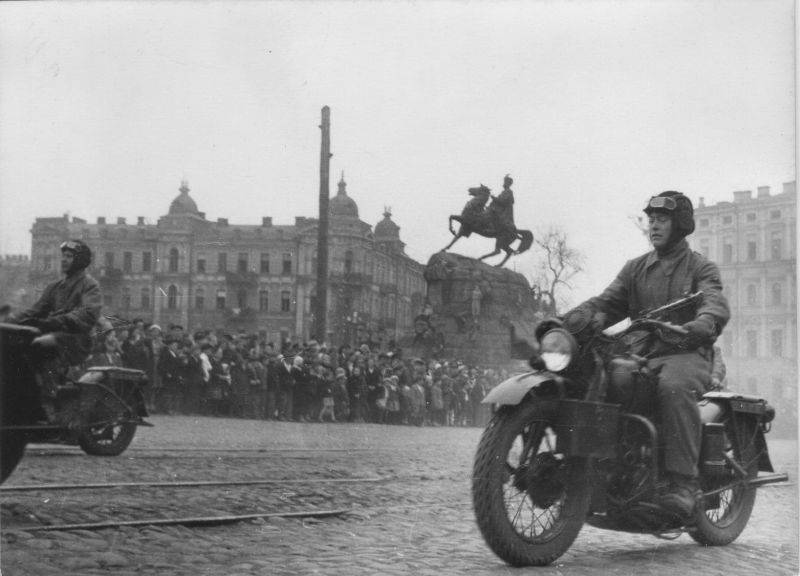
Soviet soldiers on American-made Harley-Davidson WLA-42 motorcycles move in a parade along Volodymyrska Street past the monument to Hetman of Ukraine Bohdan Khmelnitsky on Sofia Square in Kiev. May 1, 1945
Motorcycle units from the first days of the Great Patriotic War existed in the Red Army. The main time of “Stalin's motorcyclists” came when our army went on the offensive. They were used in reconnaissance, deep raids behind enemy lines and to capture important objects.
From the history of motorcycle parts in the USSR
During the First World War, cavalry was used for reconnaissance and raids in the rear.
In the period between the First and Second World Wars, the mechanization of the army takes place. In particular, there is a wide development of motorcycle and scooter (bicycle) units and units. Often they were created on the basis of cavalry units and adopted their tasks. For example, in Belgium, cyclists and motorcyclists completely replaced cavalrymen, although the Belgian cavalry units retained their name, they no longer had horses, but only bicycles, motorcycles and cars.
In Nazi Germany, motorcycle battalions were formed as part of mobile units. In terms of their composition, they were no different from ordinary motorized infantry, only instead of trucks or armored personnel carriers they used motorcycles. Also, motorcyclists made up a significant part of the reconnaissance battalions of divisions. In some SS divisions, entire motorcycle regiments were created.
The German motorcycle battalion of the 1941 model of 850 people consisted of five companies: three motorcycle, machine gun and heavy weapons. The battalion had 54 light and 14 heavy machine guns, 9 anti-tank rifles, 27 50-mm and 6 81-mm mortars, 2 75-mm infantry and 3 37-mm anti-tank guns, 2 communications armored vehicles.
The Red Army was somewhat lagging behind this global process, as the country lacked the capacity to produce motorcycles and bicycles. And yes, the space was huge. Therefore, the cavalry was not as radically reduced as in the countries of Western Europe. It is worth noting that the Soviet cavalry during the Great Patriotic War also contributed to the overall victory.
The first motorcycle units appeared in the Red Army in 1935. They were created during the reorganization of mechanized corps. Motorcycle platoons were created as part of communications battalions and separate reconnaissance battalions of mechanized corps. There was also a motorcycle platoon in the reconnaissance company and a motorcycle squad in the communications company of each mechanized brigade of the corps.
In February 1940, motorcycle battalions were formed in the Moscow, Kiev and Belorussian special military districts. As part of the mechanized corps, motorcycle regiments are already being created. The regiment consisted of three battalions.
In total, there were 1 personnel and 685 motorcycles in the motorized regiment. The armament of the regiment was weak and consisted of 731 27-mm mortars, 50 light machine guns, 81 vehicles, 73 radio stations. The motorcycle battalion consisted of three companies of three platoons each. The platoon has three squads of 5 people each: 11 motorcycles with a sidecar and 6 light machine guns), a mortar squad - 6 1-mm mortar, 50 motorcycles with a sidecar, 3 light machine guns.
In February 1941, the staff of the motorized regiment was changed. Now it had 4 companies. The total number of personnel did not decrease much - it became 1 people, but the number of motorcycles decreased - 417 motorcycles with a sidecar, 389 motorcycles without a sidecar. The regiments were well armed: 45 heavy and 16 light machine guns, 192 medium armored vehicles, 17 6-mm guns (anti-tank battery), 45 24-mm mortars, 50 knapsack flamethrowers, 20 vehicles.
The Manual of Motorcycle Troops was published only in the summer of 1941. The following tasks were set there: "The actions of motorcycle units must be bold, enterprising, cunning, mislead and create panic behind enemy lines."
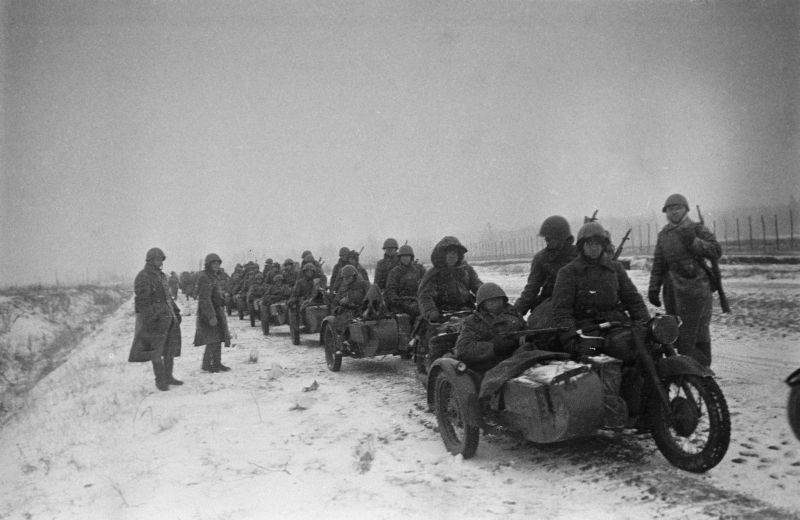
A column of Soviet motorcyclists during a stop on the highway in the Mozhaisk direction. October 1941
Motorcycles
The main army motorcycle was a heavy motorcycle TIZ AM-600. It was produced in 1935-1941. Taganrog Tool Plant No. 65 named after Comrade Stalin (after the evacuation - the Tyumen Motorcycle Plant). Thanks to the high technical culture of production, TIZ AM-600 motorcycles have gained a reputation as reliable and durable machines.
Also, since 1940, a decision was made to produce heavy motorcycles M-72. They were a copy of the German motorcycle BMW R71, which has proven itself well in the Wehrmacht. Since the spring of 1941, M-72s have been produced at the Moscow Motorcycle Plant (MMZ).
The Likhachev Plant (ZIS) developed the documentation and supplied engines, the Moscow Automobile Plant - gearboxes, GAZ - a cardan shaft and a side carriage. Another production base was the Kharkov plant. In Leningrad, the Krasny Oktyabr plant was also entrusted with the production of the M-72. On February 25, 1942, M-72 motorcycles began to be produced in Irbit, where equipment from Moscow factories was evacuated.
In total, 16 motorcycles were produced during the war years.
There were other models, but less massive. By the beginning of the war, there were up to 5 motorcycles in the Red Army in the western direction. Production was just being established, it could not yet meet the needs of the Armed Forces.
For comparison: the Wehrmacht had more than 90 thousand motorcycles in total, and more than 30 thousand on the Soviet border.
There were not enough cars, in some motorized regiments they did not have time to get them.
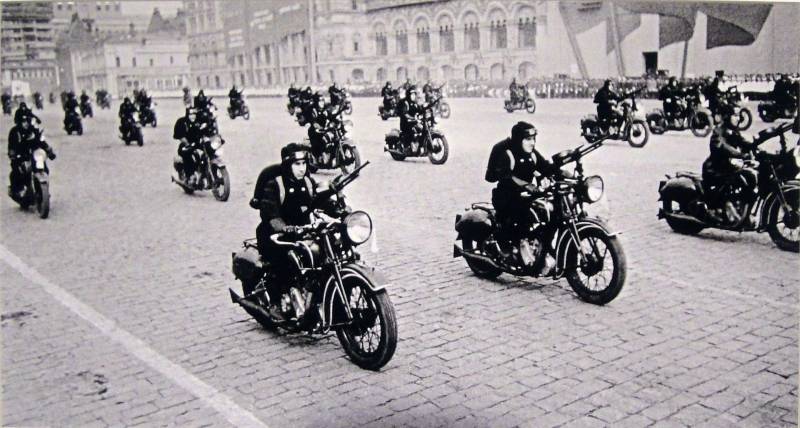
Machine gunners-motorcyclists on a TIZ AM-600 motorcycle at a parade on Red Square. Moscow, 1936
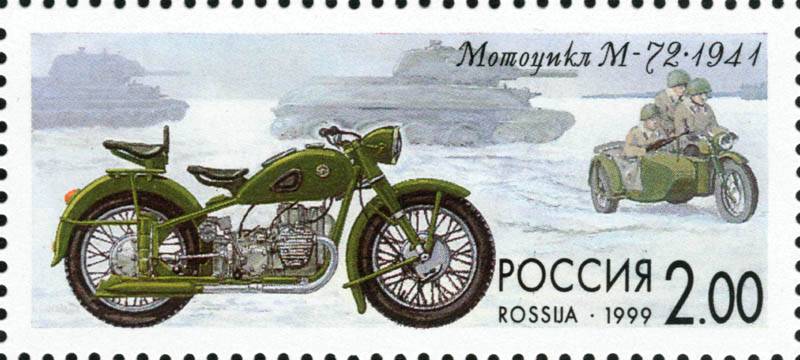
M-72 on a Russian postage stamp
Reinforcement of motorcycle parts
At the beginning of the war, motorcycle regiments suffered heavy losses and were partially disbanded. But then new separate battalions and regiments were created, which were often armed with foreign equipment, including American Harley-Davidson motorcycles.
Motorcycle battalions were part of tank and mechanized corps, regiments - armies. The formed separate motorized battalions initially consisted of three motorcycle and one armored car company.
But by 1943, the composition of the battalion changed again, and two motorcycle companies remained in it. But a tank company, an armored personnel carrier company and an anti-tank battery (4 45-mm guns) were added. In total, the battalion had 450 people, 111 motorcycles, 10 tanks, 5 armored vehicles, 10 armored personnel carriers.
Motorized regiments differed from the battalion only in that they had an additional machine-gun and mortar company, a battery of 76-mm cannons, and another anti-tank battery. In total, the regiment in the state consisted of 1 people, 188 motorcycles, 214 tanks, 10 armored personnel carriers, 18 armored cars, 3 wheeled American Scout armored personnel carriers, 13 8-mm self-propelled anti-tank guns (American T57), a battery of 48-mm guns, 76 9 -mm mortars.
That is, by the end of the war, motorcycle units received armored vehicles and heavy weapons, their motorcycle unit was reduced.
It is also interesting that motorcycle regiments became one of the few units of the Red Army where foreign equipment was used so massively (motorcycles, jeeps, tanks, wheeled self-propelled guns and armored personnel carriers).
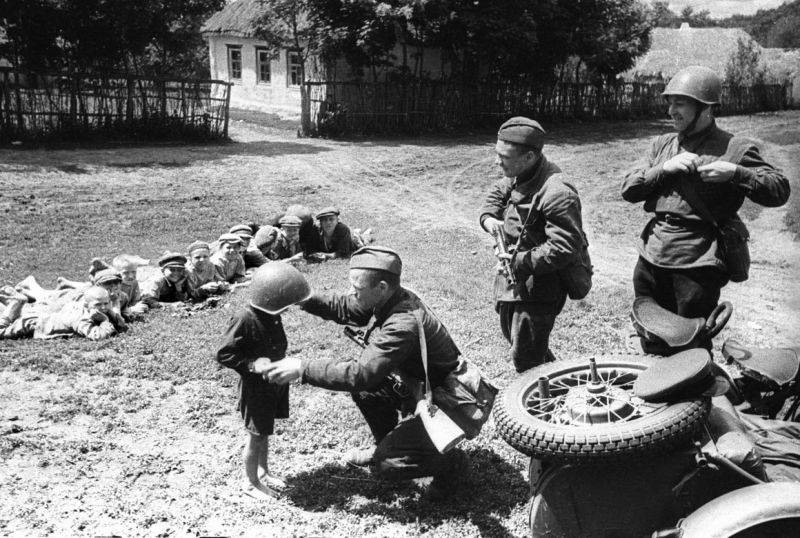
Soldiers of the 51st Separate Motorcycle Battalion of the 22nd Tank Corps of the 38th Army of the Southwestern Front with Soviet children. 1942
Motorcyclists in combat
In the defensive battles of the initial period of the war, the motor units suffered heavy losses. Light mobile units were not intended for heavy defensive battles and containment of enemy infantry and tank formations. And they were not suitable for serious counterattacks. This is the business of armored formations. But the motorcyclists fought bravely.
So, in archival documents available on the website "Memory of the People", there is information about the feat of the 7th separate motorcycle regiment, whose formations fought in Karelia from the beginning of July 1941 and launched a successful counteroffensive in the area of the Vidlitsa River, having managed to recapture the Salmi station from the Nazis and several towns. Then the motorcyclists covered the retreat of the main forces, fighting with superior enemy forces.
It is not surprising that the command draws certain conclusions and regularly strengthens the engine parts with heavy weapons. When the Red Army goes over to the offensive, the mobile units and formations become the spearhead of the troops. They were the “light cavalry” of the army: they carried out deep reconnaissance, raids in the rear, captured important crossings and bridges, were the first to break into cities and towns, disrupted communications and the enemy’s rear.
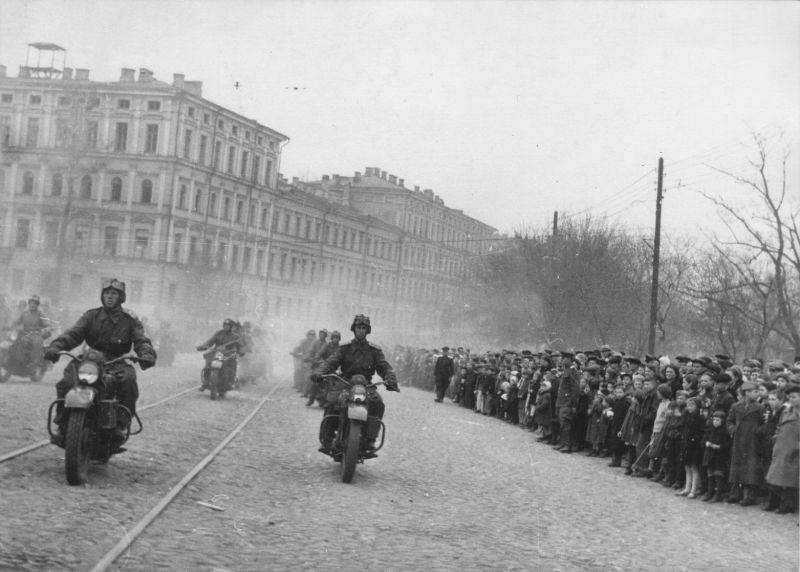
Soviet soldiers on Harley-Davidson motorcycles parade past the monument to Bohdan Khmelnitsky in Kyiv. May 1, 1945
Well-armed motorized regiments were completely autonomous and could move forward 150–200 km from the main forces. At the forefront on motorcycles was a company of machine gunners and a platoon of mortars, a battery of light self-propelled guns and a battery of 76-mm ZiS-3 guns with artillerymen and sappers on trucks. They were followed in two echelons by the main forces: two motorcycle companies, the remaining artillery, self-propelled guns, tanks, a control company, rear units (medical unit, repairs and supplies).
For example, this is how the 4th separate motorcycle regiment acted during the capture of the Romanian cities of Byrlad and Focsani in August 1944. "Stalin's motorcyclists", causing panic in the ranks of the enemy, immediately broke through to the airfield near Byrlad and destroyed 8 aircraft there. Then, waiting for the approach of the main forces, our soldiers developed an offensive, broke through to the city center and captured the railway station. In this operation, the motorized regiment accounted for more than 1 enemy soldiers and officers, several tanks and self-propelled guns, about 500 vehicles and 40 carts.
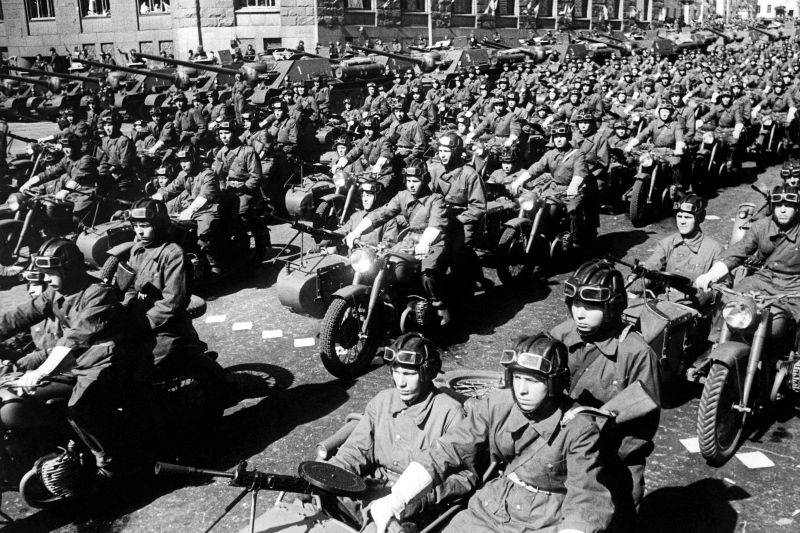
Fighters on motorcycles M-72 and self-propelled guns SU-100 are moving towards Red Square to participate in the Victory Parade. June 24, 1945
Heavy fighting with the Germans continued until the very end of the war.
So, in early February 1945, the 2nd Separate Guards Motorcycle Regiment and the 271st Separate Motorized Special Purpose Battalion made a successful raid on the rear of the enemy in East Prussia. They smashed small units and the rear of the enemy, sank barges, freed our compatriots who had been driven to work in Germany, prisoners.
Then the mobile units withdrew to the village of Tirenberg, where the headquarters of the 91st Guards Rifle Division was located. The division broke through the enemy defenses, occupying the villages of Tirenberg (now does not exist) and Germau (now the village of Russkoe). Our troops reached the coast of the Baltic Sea south of Palmniken (now Yantarny), cutting off the escape route to Königsberg (Russian Kaliningrad) for German units located in the northern part of the Zemland Peninsula.
Meanwhile, a large formation of Germans unexpectedly appeared on the Zemland Peninsula. The 28th Army Corps under the command of General Hans Golnik, who survived the January battles in the neighborhood on the Memel bridgehead. The German corps passed along the Curonian Spit and entered the Zemland Peninsula. Straight to the rear of the 91st Guards Rifle Division, in which 3,5 thousand soldiers remained after heavy offensive battles. There was a threat of death of the division.
To save the division, a heavy rearguard action was taken by motorcycle warriors of the 2nd Guards Motorcycle Regiment, soldiers of the 271st Special Amphibian Battalion and the SMERSH Counterintelligence Department of the 91st Guards Rifle Division. In total, about 1 thousand fighters. Soviet soldiers fought for four days - from 4 to 7 February. In the battles, the commander of the motorcycle regiment, Lieutenant Colonel Matvey Kupin, was killed, more than 200 soldiers and officers died in total. But the heroes completed the task. The division successfully withdrew.
Soon the enemy will be defeated, Koenigsberg will be taken.
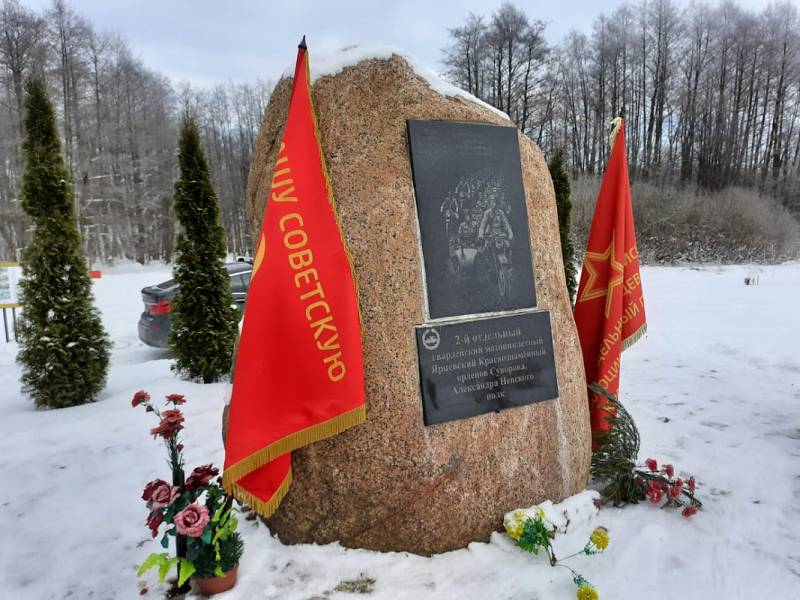
Memorial to warriors-motorcyclists, installed near the village of Shatrovo, Zelenograd urban district, Kaliningrad region
Information